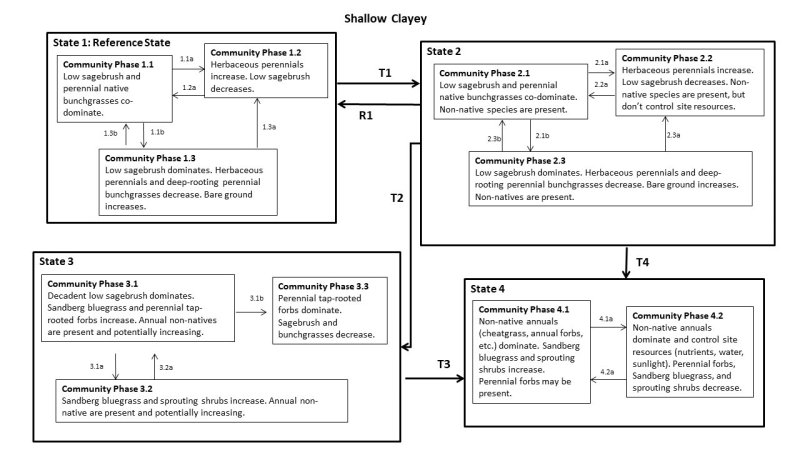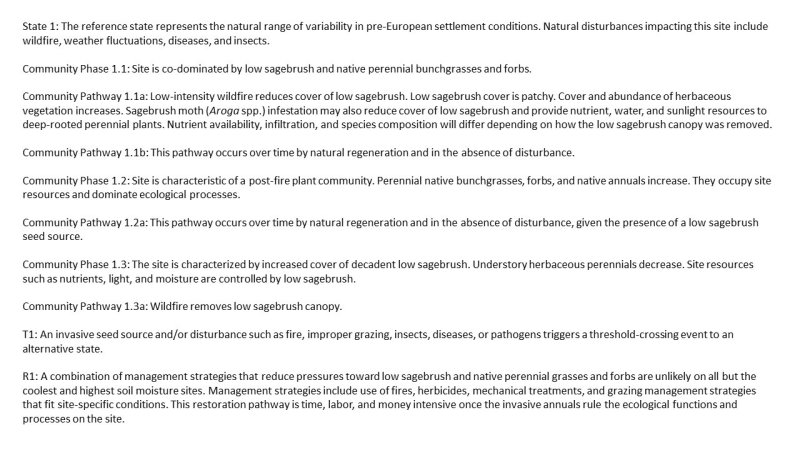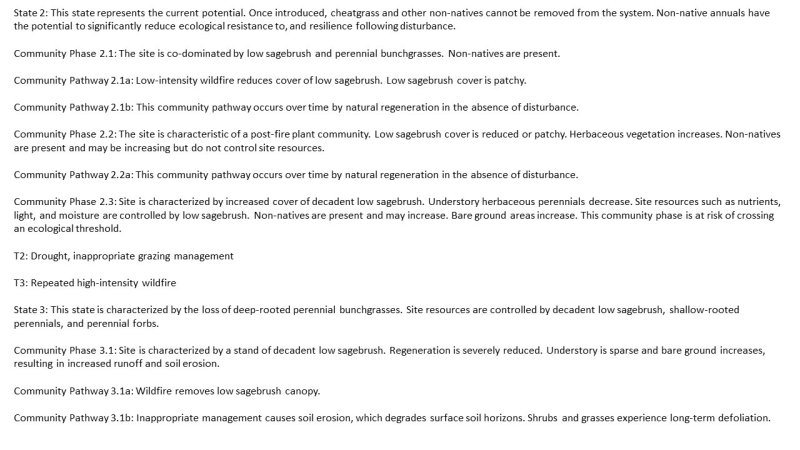Ecological site group R021XG906CA
Shallow Clayey
Last updated: 06/13/2025
Accessed: 12/20/2025
Ecological site group description
Key Characteristics
- Upland sites
- 12-30" ppt
- < 20" depth
- Clayey texture
Provisional. A provisional ecological site description has undergone quality control and quality assurance review. It contains a working state and transition model and enough information to identify the ecological site.
Physiography
This ESG is extensive. It covers a variety of landforms within MLRA 21 such as hills, mountains, escarpments, rock benches, terraces, tablelands, stream terraces, fan remnants, and lava plateaus. Slopes are 2 to 75 percent but are typically less than 15 percent.
Climate
The average annual precipitation in this MLRA is typically 9 to 25 inches (241 to 635 millimeters). It is highest, up to 57 inches (1,450 millimeters), in small areas at high elevations on the western and southwestern edges of this MLRA. Other high precipitation zones are in the scattered mountain ranges throughout the rest of this area. Most of the rainfall occurs as low- or moderate-intensity Pacific frontal storms during the winter. At the higher elevations, rain generally turns to snow. Snow may fall at the lower elevations in winter but does not last. Summers are dry. The average annual temperature is 37 to 53 degrees F (3 to 12 degrees C). The frost-free period averages 130 days and ranges from 70 to 185 days.
Soil features
This ESG is extensive within the 12-to-30-inch (305-to-760-millimeters) precipitation zone of MLRA 21. It is on soils that are well drained or moderately well drained, very shallow or shallow to a water-restricting horizon such as a duripan, hardpan, etc., and formed in alluvium derived from volcanic rocks.
Representative soils include the Yancy (clayey, smectitic, frigid, shallow Palexerollic Durixerolls), Lorella (clayey-skeletal, smectitic, mesic lithic Argixerolls), Jellycamp (clayey, smectitic, mesic, shallow Abruptic Argiduridic Durixerolls), Bieber (clayey, smectitic, mesic shallow Argiduridic Durixerolls), and Ninemile series (clayey, smectitic, frigid Aridic Lithic Argixerolls).
Vegetation dynamics
This habitat is generally dominated by broad-leaved, evergreen shrubs ranging in height from about 4 to 19 inches (0.1 to 0.5 meters). Average shrub cover is typically 15 percent, but sometimes crowns touch. There may be deciduous shrubs and small trees sparsely scattered within this type. Grasses and forbs are typically sparse, providing 5 to 15 percent ground cover.
The habitat may be dominated by either low sagebrush or black sagebrush, often in association with yellow rabbitbrush, antelope bitterbrush, or big sagebrush. Western juniper may be sparsely scattered in stands dominated by low sagebrush, and Utah juniper and singleleaf pinyon are sometimes scattered in stands dominated by black sagebrush. Common grass species include Sandberg bluegrass, bluebunch wheatgrass, bottlebrush squirreltail, Thurber’s needlegrass, and Idaho fescue. A rich variety of forbs is usually present. The abundance and distribution of associated plants are highly influenced by soils and precipitation.
This type commonly forms ecotones with the Sagebrush, Pinyon-Juniper, and Juniper habitats in northeastern California. Indeed, it may be difficult to determine the correct classification of some sites: "On the Modoc Plateau, low sagebrush (Artemisia arbuscular) communities are common as openings within the coniferous forest". They may thus be found adjacent to Mixed Conifer, Jeffrey Pine, or Ponderosa Pine forests. Climatic changes result in periodic shifting of these ecotones, a relationship that is further complicated by invasion of coniferous woodlands into sagebrush habitats in response to fire suppression and grazing by domestic livestock.
Low sagebrush occurs in areas with cold, harsh winters and hot, dry summers. Precipitation generally ranges from 20 to 46 cm (8 to 18 in), falling mostly as snow from December through March. Mean summer maximum temperatures range from 28 to 35 C (83 to 95 F); mean winter minimum range from -13 to -3 C (8 to 27 F). Stands of low sagebrush are "usually found on shallow soils with impaired drainage in the transition zone between the wetter bottom and open timber on the mountainsides." The type also occurs on terraces with hardpan or heavy clay soils. In mosaics formed with bitterbrush, low sagebrush occurs on harsher sites with shallow, well-drained soils, and bitterbrush occupies areas with deeper soils. The clay-rich soils yield much of their snowmelt as runoff, making them very important watershed areas. Perched water tables in spring, which result in poor aeration in the rooting zone of low sagebrush, may be significant in the ecology of the LSG habitat.
Major Land Resource Area
MLRA 021X
Klamath and Shasta Valleys and Basins
Subclasses
- R021XE104CA–STONY SANDS
- R021XE107CA–CLAY BASIN 14-18
- R021XE074CA–FINE LOAMY
- R021XE108CA–COBBLY CLAY 14-16
- R021XE109CA–COBBLY LOAM 14-16
- R021XE110CA–COBBLY SANDY LOAM 16-18
- R021XE111CA–COOL COBBLY LOAM 16-18
- R021XE112CA–COOL DEEP LOAM 16-18
- R021XE113CA–DEEP LOAM 14-16
- R021XE114CA–DIATOMACEOUS LOAM 14-16
- R021XE115CA–ERODED SHALLOW GRAVELLY LOAM 14-16
- R021XE116CA–GRAVELLY LOAM 14-18
- R021XE117CA–LOAM 14-16
- R021XE118CA–LOAMY CLAYPAN 16-18
- R021XE119CA–LOAMY MOUNDS 14-16
- R021XE120CA–SANDY LOAM 14-16
- R021XE121CA–SHALLOW COBBLY CLAY 14-16
- R021XE122CA–SHALLOW COBBLY LOAM 14-16
- R021XE123CA–SHALLOW COOL GRAVELLY LOAM 16-18
- R021XE124CA–SHALLOW COOL VERY STONY LOAM 16-18
- R021XE125CA–SHALLOW GRAVELLY LOAM 14-16
- R021XE126CA–SHALLOW LOAM 14-18
- R021XE127CA–SHALLOW LOAMY INTERMOUNDS 14-16
- R021XE128CA–SHALLOW SANDY LOAM 14-16
- R021XE129CA–SHALLOW VERY STONY LOAM 14-18
- R021XE130CA–STONY LOAM 14-18
- R021XE131CA–LOAMY
- R021XE132CA–DRY LOAMY
- R021XE133CA–SHALLOW LOAMY
- R021XE134CA–SHALLOW STONY UPLANDS
- R021XE135CA–CLAYEY SLOPES
- R021XY204OR–SHALLOW STONY 10-20 PZ
- R021XY206OR–DEEP LOAMY 10-14 PZ
- R021XY208OR–SANDY 10-14 PZ
- R021XY210OR–LOAMY 14-18 PZ
- R021XY211OR–SHRUBBY LOAM 12-16 PZ
- R021XY212OR–SHALLOW LOAM 14-18 PZ
- R021XY214OR–CLAYPAN 14-18 PZ
- R021XY215OR–CLAYPAN 14-20 PZ
- R021XY216OR–STONY CLAYPAN 14-20 PZ
- R021XY218OR–SHRUBBY LOAM 16-20 PZ
- R021XY300OR–SOUTH SLOPES 10-14 PZ
- R021XY301OR–JUNIPER SOUTH 12-16 PZ
- R021XY302OR–NORTH SLOPE 10-14 PZ
- R021XY306OR–STONY CLAYPAN SOUTH 14-18 PZ
- R021XY308OR–SOUTH SLOPES 14-18 PZ
- R021XY310OR–SHALLOW NORTH 14-18 PZ
- R021XY312OR–NORTH SLOPES 14-18 PZ
- R021XY314OR–DRY MEADOW 14-30 PZ
- R021XY316OR–BASIN HUMMOCK
- R021XY402OR–ROCKY RIDGES 14+ PZ
- R021XY403OR–MAHOGANY ROCKLAND 10-20 PZ
- R021XY406OR–WET MEADOW 14-40 PZ
- R021XY410OR–DEEP LOAMY 16-20 PZ
- R021XY411OR–PINE-MAHOGANY-FESCUE 16-20 PZ
- R021XY412OR–LOAMY 18+ PZ
- R021XY414OR–PINE/SEDGE-FESCUE 16-24 PZ
- R021XY416OR–ASPEN GROVE
- R021XY418OR–WET LOAMY TERRACE
- R021XY420OR–JUNIPER-MAHOGANY/FESCUE 16-20 PZ
- R021XY422OR–PINE-FIR/SEDGE 18-30 PZ
- R021XY424OR–JUNIPER LAVALANDS 8-11 PZ
- R021XY425OR–JUNIPER-PINE LAVALANDS 10-12 PZ
- R021XY501OR–JUNIPER CLAYPAN 16-20 PZ
- R021XY503OR–EPHEMERAL LAKEBED 10-20 PZ
- R021XY505OR–JUNIPER CLAYPAN 12-16 PZ
- R021XY506OR–CLAYPAN BOTTOM 12-18 PZ
- R021XY508OR–JUNIPER DRY PINE 14-16 PZ
- R021XY509OR–SEMI-WET MEADOW 14-20 PZ
- R021XY510OR–PINE/FESCUE BOTTOM 12-18 PZ
- F021XE230CA–Pinus ponderosa/Symphoricarpos rotundifolius/Achnatherum
- F021XE231CA–Abies concolor var. lowiana/Symphoricarpos rotundifolius/Bromus marginatus
- F021XE232CA–Pinus contorta var. murrayana/Arctostaphylos nevadensis/Carex rossii
- F021XE233CA–Populus tremuloides/Symphoricarpos rotundifolius-Artemisia tridentata ssp. vaseyana/Bromus marginatus
- F021XE234CA–Populus tremuloides/Symphoricarpos rotundifolius/Bromus marginatus
- F021XE235CA–Pinus albicaulis/Ribes montigenum/Achnatherum occidentale ssp. occidentale
- F021XE236CA–Pinus washoensis-Abies concolor var. lowiana/Symphoricarpos rotundifolius/Bromus marginatus
- F021XE237CA–Juniperus occidentalis var. occidentalis/Artemisia tridentata ssp. vaseyana/Achnatherum thurberianum
- F021XE238CA–Populus balsamifera ssp. trichocarpa/Salix lucida ssp. lasiandra/Elymus trachycaulus ssp. trachycaulus
- F021XE239CA–Abies concolor var. lowiana-Pinus monticola/Achnatherum occidentale ssp. occidentale
- F021XE240CA–Pinus contorta var. murrayana/Achnatherum
- F021XG913CA–Wet Clayey
- F021XG914CA–Wet Loamy
- R021XE006CA–COARSE LOAMY 14-16"
- R021XE044CA–Cool Loam 12-16 Fine-loamy
- R021XE088CA–SANDY
Stage
Provisional
Click on box and path labels to scroll to the respective text.



